Mountains hold a quiet draw for many people. Whether it’s Everest’s intimidating summit or the peaceful valleys of the Alps, these landscapes offer opportunities for adventure, reflection, and connection.
In this guide, we at Remitly will take you on a journey across the world’s most famous mountain ranges, highlighting iconic peaks, practical travel tips, and cultural insights. From accessible trails for beginners to challenging slopes for experienced hikers, the world’s mountains create memorable experiences for every type of traveler.
The Himalayas: crown jewels of Asia
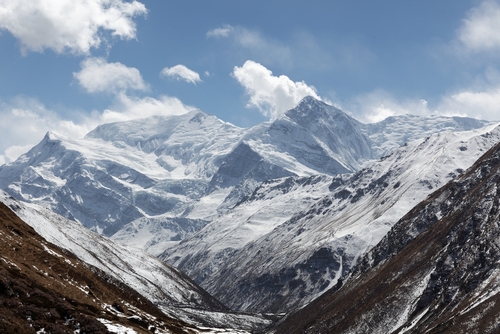
The Himalayas are among the most widely revered mountain destinations in the world. Stretching across Nepal, Tibet, India, Bhutan, and Pakistan, they are home to the highest mountain peaks on Earth, including Mount Everest, K2, and Annapurna.Visiting this region can be as much about connecting with local culture as exploring the landscape. Along the way, you’ll see Buddhist monasteries, colorful prayer flags, and ice-cold rivers fed by glaciers. Small villages offer chances to meet people who have maintained traditions for generations, giving you a deeper sense of life beyond the peaks.
Experiencing the Himalayas
Even if climbing Everest feels out of reach, you can still experience all the Himalayas offer. Popular treks, like Everest Base Camp or the Annapurna Circuit, let you enjoy scenic views without needing technical climbing skills.
For experienced hikers, Bhutan’s Snowman Trek is one of the world’s most remote and demanding routes—challenging even seasoned trekkers.
If you’d rather take it easy, flights over Everest and the surrounding peaks provide expansive aerial views without the physical strain. Small towns like Namche Bazaar in Nepal or Leh in Ladakh offer lively markets, cozy guesthouses, and opportunities to experience daily life firsthand.
Himalayas travel tips
- Best seasons: Spring (March–May) and autumn (September–November) often have the clearest skies and most stable weather.
- Accessibility: Some treks require permits, and guides may be recommended before visiting certain areas. Check ahead with local authorities to simplify planning.
- Safety: Ascend gradually and stay hydrated to reduce the effects of altitude sickness. Setting aside time for rest days can also help your body adjust.
The Alps: Europe’s adventure playground
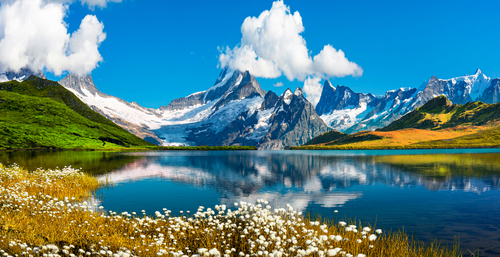
The Alps spread over several countries, including Italy, France, Austria, Switzerland, Liechtenstein, Germany, Slovenia, and Monaco. While Switzerland and Austria have the largest Alpine areas, Italy has the most mountain peaks.
Famous mountain destinations like Mont Blanc, the tallest summit in Western Europe, and the Matterhorn, with its distinctive pyramidal shape, draw travelers from around the world. But the Alps offer more than hiking and skiing: visiting lets you experience local villages and cuisines while learning about regional traditions.
Experiencing the Alps
The Alps are covered in snow in winter, making them a popular ski and snowboarding spot. When the snow melts, trails open for hiking, climbing, and mountain biking, allowing you to enjoy alpine meadows, glacial rivers, and rocky ridges at your own pace.
For a less strenuous experience, scenic trains like Switzerland’s Glacier Express or cable cars like the Eiger Express provide easy access to panoramic views.
But if you’re looking for more adventure, via ferrata routes—protected climbing paths with cables and ladders—let you safely reach higher elevations even without technical climbing experience.
Villages like Chamonix, Zermatt, or Cortina d’Ampezzo are known for their comfortable restaurants, local markets, and seasonal festivals. They offer you different ways to discover Alpine culture.
The Alps travel tips
- Best seasons: Winter (December–April) is best for skiing, while summer (June–August) is the time for hiking and lake adventures. Shoulder season (May, September, and October) often has fewer crowds.
- Accessibility: Most trails are open to climbers of all levels, no permits required. Well-maintained trails, mountain huts, cable cars, and trains make it easy to access these majestic mountains safely.
- Safety considerations: Weather can change quickly, so pack layers, check local forecasts, and prepare for sudden storms.
The Andes: South America’s mighty backbone
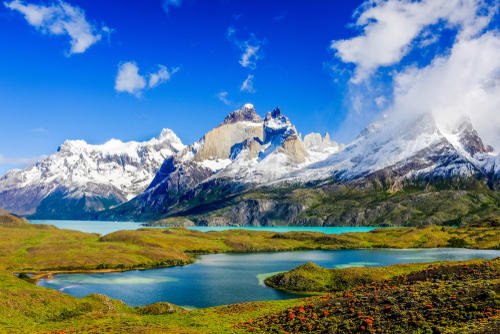
At over 4,300 miles (7,000 kilometers), the Andes are the world’s longest continental mountain range. They occupy seven countries: Argentina, Venezuela, Colombia, Ecuador, Peru, Bolivia, and Chile.
Here, jagged peaks, volcanic landscapes, and vast wilderness combine with rich cultural heritage. Legendary peaks like Aconcagua—the tallest one outside the Himalayas—share the stage with Patagonia’s windswept valleys and the Inca Empire’s ancient routes.
Traveling through the Andes can be an exciting cultural experience. Along the way, you’ll meet communities preserving their centuries-old way of life through farming, weaving, and cheese-making. Experiencing these towns provides a window into the region’s living history.
Experiencing the Andes
If you enjoy trekking, Peru’s Inca Trail leads to Machu Picchu, blending history, nature, and culture. Ecuador’s Quilotoa Loop offers crater-lake views, while Patagonia’s Torres del Paine Circuit provides solitude, dramatic landscapes, and incredible photo opportunities.
For experienced climbers, Aconcagua and Chile’s volcanoes offer challenging ascents that require careful preparation and acclimatization.
For cultural enthusiasts, the Otavalo Market in Ecuador is a well-known indigenous market where you can buy textiles, handcrafted jewelry, leather goods, and artwork. Nearby, the village of Peguche showcases the making of traditional instruments like panpipes and drums, giving a tangible sense of local craft and music.
Andes travel tips
- Best Seasons: May to September offer the clearest skies in most trekking regions.
- Accessibility: Hiring local guides can help you navigate trails safely and deepen your cultural experience.
- Safety considerations: Many areas sit at elevations above 8,000 feet (2,500 meters), so altitude sickness is a real concern. Allow time to acclimatize, stay hydrated, and ascend gradually to reduce the effects.
- The Rockies: North America’s wild frontier
The Rocky Mountains are among the best mountain destinations to visit in North America. They cut across the US and Canada, offering vast wilderness that feels both grand and accessible.
Highlights include Denali in Alaska, Mount Whitney in California, and the stunning Canadian Rockies in Alberta and British Columbia. The Rockies are also home to some of the world’s most visited national parks like Yellowstone, Banff, and Jasper, protecting landscapes where bears, elk, and mountain goats roam freely.
Experiencing the Rockies
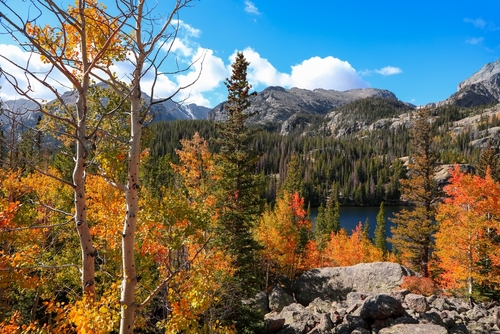
The Rockies offer experiences for every type of traveler. Short, rewarding hikes in places such as Emerald Lake in Colorado or Johnston Canyon in Alberta let you enjoy the mountains at a relaxed pace. Scenic drives along Colorado’s Trail Ridge Road or Canada’s Icefields Parkway showcase glaciers, waterfalls, and sweeping valleys.
If you’re up for a challenge, popular trails include Lake Louise and Moraine Lake in Canada, and the Highline Trail in Montana’s Glacier National Park. Multi-day backpacking options like Jasper’s Skyline Trail or Wyoming’s Teton Crest Trail provide longer, immersive treks.
In winter, the Rockies are covered in snow, so you can ski, snowshoe, and ice climb. Resorts like Whistler Blackcomb, Aspen, and Banff Sunshine Village offer a variety of experiences for all skill levels.
Beyond outdoor adventure, tours led by local guides provide insight into indigenous traditions, stories, and historic sites. Natural hot springs like Banff Upper Hot Springs in Alberta or Strawberry Park in Colorado offer a chance to relax in nature.
Rockies travel tips
- Best seasons: June to September are great for hiking, while winter is for skiing and snowshoeing.
- Accessibility: Trails range from gentle valley paths to challenging mountain peaks.
- Safety considerations: Wildlife is common in many areas. Bring bear spray when recommended, monitor the weather, and follow park guidelines to help you stay safe.
Discover hidden mountain gems
If you’re looking to escape the crowds, these hidden ranges are worth exploring.
The Caucasus Mountains

Straddling Europe and Asia, the Caucasus Mountains are home to Mount Elbrus, Europe’s highest peak, standing at 18,510 feet (5,642 meters). Villages preserve centuries of traditions, and walking along ancient shepherd trails, exploring medieval towers, or attending local festivals lets you connect with welcoming communities.
The region is also known for its hearty mountain cuisine and freshly baked breads.
You can reach the Caucasus by flying into Mineralnye Vody in Russia or Tbilisi in Georgia. Then, take a local bus or hire a driver to reach popular mountain towns like Kazbegi or Elbrus Base.
- Best seasons: Late spring to early autumn (May–September) for accessible trails and mild weather.
- Accessibility: Local guides are highly recommended for safety and navigation. Some trails are remote, so plan transportation in advance.
- Safety considerations: Weather can change rapidly, so bring layered clothing and be cautious on high-altitude trails.
The Atlas Mountains
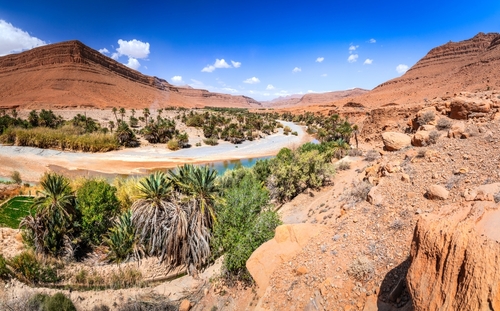
Morocco’s Atlas Mountains combine rugged terrain with vibrant culture. Trekking past Berber villages shows a way of life that’s largely remained unchanged over generations. Staying in small guesthouses (“gîtes”) gives a firsthand experience of local hospitality.
The mountains themselves vary from snow-capped peaks to hidden gorges, with ancient settlements (“kasbahs”) adding historical interest.
To experience the Atlas Mountains, you can fly into Marrakech, then hire a driver or join guided tours to well-known mountain destinations like Imlil in Toubkal National Park or Aït Bouguemez Valley.
- Best seasons: Spring (March–May) and autumn (September–October) offer hiking opportunities and moderate temperatures.
- Accessibility: Treks vary in difficulty. Hiring a local guide enhances safety and cultural insight.
- Safety considerations: Some paths are steep or rocky, so sturdy shoes and trekking poles are recommended.
The Southern Alps
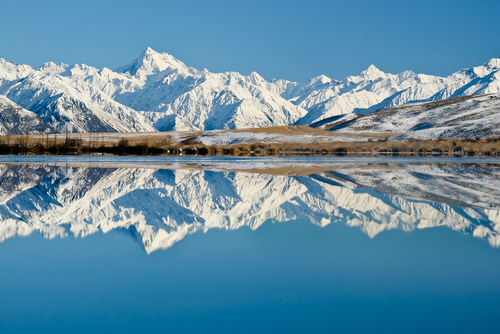
The Southern Alps in New Zealand stretch along the South Island, with dramatic ridges, glaciers, and fjords. Hiking trails like the Routeburn Track or the Kepler Track provide up-close glacier views, alpine passes, and encounters with unique wildlife, such as kea parrots. Multi-day treks let you explore the mountains at your own pace, often in solitude.
Fly into Queenstown or Christchurch, then take a shuttle, rental car, or guided tour to trailheads such as Glenorchy (Routeburn) or Te Anau (Kepler).
- Best seasons: Late spring to early autumn (November–April) for accessible trails and mild weather.
- Accessibility: Popular treks require advance booking for alpine huts. Guided tours are best for backcountry exploration.
- Safety considerations: Bring in layers, rain gear, and enough supplies so you can feel prepared for multi-day treks.
Advantages of hidden gems
One of the joys of exploring hidden gems is the chance for solitude. You’ll find quiet trails where you can pause, reflect, and fully immerse yourself in nature without worrying about the crowds.
These ranges also give you the chance to learn about local traditions, foods, and ways of life, offering interactions you might not find in busier destinations.
Plus, visiting these out-of-the-way mountain ranges can be more budget-friendly, with accommodations, guides, and meals costing less than in heavily visited areas..
Preparing for your mountain adventure
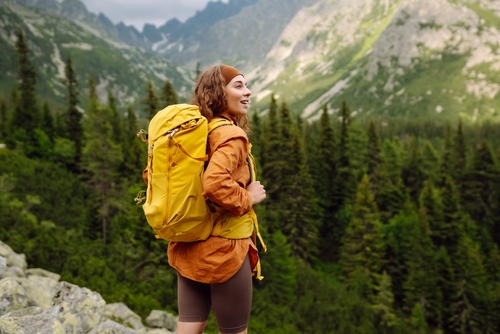
Preparation is key to a safe and rewarding journey. Here are some things you should consider:
Fitness and gear
Preparing for a mountain journey starts with you and your comfort. Build your stamina through walks, hikes, or cardio exercises to feel confident on trails. Bring the right gear, like sturdy boots, layered clothing, and trekking poles, to make your adventure safer and more enjoyable. And if you’re tackling higher altitudes or multi-day treks, more specialized equipment can make a big difference.
Types of experiences
You can tailor your mountain adventures to be as relaxed or challenging as you like. Short day hikes, scenic drives, or cable car trips are perfect for beginners. Meanwhile, multi-day trekking circuits or climbing expeditions suit those seeking a true adventure.
Budget and logistics
Think about local transportation, accommodation, meals, guide fees and gear, and decide if you prefer guided tours or independent travel. Travel insurance and emergency planning can provide additional peace of mind.
Respecting mountain environments
Mountains are fragile ecosystems. You can make a positive difference by following Leave No Trace principles, including disposing of waste, minimizing campfire impacts, and respecting wildlife and local communities.
Climate change affects mountain regions, so choosing eco-friendly accommodations and supporting conservation initiatives also helps protect these areas for future travelers.
Even photography requires mindfulness. Capturing the perfect shot should never come at the expense of harming plants, wildlife, or sensitive terrain.
Start planning your mountain journey
The world’s mountains offer experiences for every kind of traveler, whether you’re seeking adventure, cultural insight, or quiet reflection. Start small with local or accessible ranges to build confidence, then gradually explore more challenging peaks as you feel ready. Prepare physically, research destinations, and connect with local guides to make the most of your journey.
FAQs
What’s the best time of year to visit mountain regions?
The best time to visit depends on the location. Spring and autumn are ideal for trekking in the Himalayas and Andes, summer for the Alps and Rockies, and winter for skiing in the Alps and Rockies.
Do I need special equipment to explore mountain ranges?
Basic gear includes sturdy boots, layered clothing, trekking poles, and navigation tools. However, high-altitude climbs require specialized climbing gear and safety equipment.
How do I prepare physically for mountain adventures?
Focus on building endurance by training through cardio, strength exercises, and hikes with a weighted backpack. Spending time acclimatizing gradually can help at higher altitudes.
Are mountain destinations suitable for families with children?
Yes, many ranges have family-friendly trails and activities. For younger travelers, stick to easy hikes and short excursions.
What should I know about altitude sickness?
Altitude sickness is common among climbers, especially at higher altitudes. Symptoms include headache, nausea, dizziness, and fatigue. You can prevent it by ascending gradually, staying hydrated, and resting as much as possible. Seek medical attention if symptoms worsen.